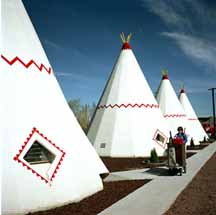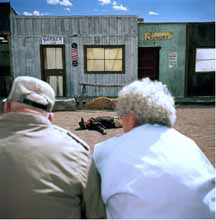Greta Pratt: Using History

About the Exhibition
Some years ago, I visited Stickney, South Dakota to photograph their centennial celebration and historical pageant. With the prairie as a backdrop the town’s people enacted their history starting with Lewis and Clark, followed by women in sunbonnets and calico dresses, and missionaries dressed in black. During the intermission, the master of ceremonies told jokes and imitated Bing Crosby, while “Indians” dressed in homemade burlap costumes, their white faces painted to portray “otherness,” gathered in the background.
I decided to photograph how Americans remember the past, in order to understand what is revealed by the events we choose to celebrate as history.
The second act brought war whoops and galloping horses to signal the demise of Custer, followed by prospectors, gold-sifting pans in hand, and cowboys driving cattle. The grand finale featured a favorite son, who had left Stickney to play in a lounge act in Fargo, returning to play “Great Balls of Fire,” on an upright piano. Later that night in my hotel room, I wondered how these events expressed history. What would the Lakota Sioux who lived on a reservation outside of Stickney think of this pageant? What would their version of history say about the last one hundred years? I decided to photograph how Americans remember the past, in order to understand what is revealed by the events we choose to celebrate as history. Initially I went to sites I studied in elementary school: Plymouth Rock, Jamestown, Gettysburg, Mount Vernon. Everywhere I went, I found others exploring the past: retired couples in RVs, and families on vacation stopping at historical markers. I met Civil War buffs and Vietnam veterans. Everyone was trying to find a way to connect to the past.
I began to understand how the framing of the past evolves…
I observed historic iconography everywhere and realized that its usage elicits a predictable response, valuable for selling merchandise, constructing identity, and invoking patriotism. I began to understand how the framing of the past evolves, reflecting the belief and ideals of the present.
These photographs are my quest to understand how I, and we, remember history. My intention with these images is to address how the culture and morality of today are reflected in what we commemorate about the past.
-Greta Pratt, 2005
Greta Pratt is the author of two monographs, Using History (Steidl, 2005) and In Search of the Corn Queen (National Museum of American Art, 1994). Pratt’s works are represented in major public and private collections, including The National Museum of American Art, Smithsonian Institution, Washington, D.C., The Museum of Fine Arts Houston, and The Minneapolis Institute of Art. She studied intermedia design at SUNY New Platz (MFA, 2005) and photography and sculpture at the University of Minnesota (BFA, 1984). Pratt has been nominated for a Pulitzer prize, served as photography bureau chief of Reuters International in New York City, worked with United Press International, and has had photo essays published in major newspapers and magazines, including The New York Times Magazine and The New Yorker.
Image Gallery

